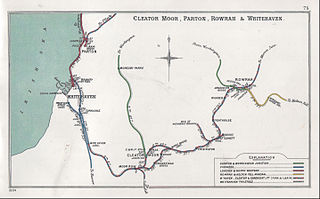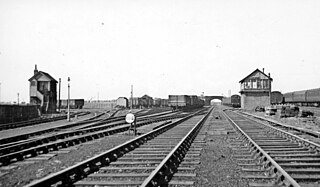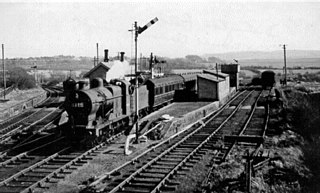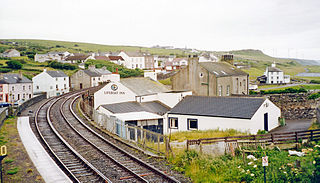Related Research Articles

Lowca had two railway stations that served the village of Lowca in the former county of Cumberland, England, which is now part of Cumbria.

Workington Central railway station was opened by the Cleator and Workington Junction Railway (C&WJR) in 1879 to serve the town of Workington in Cumberland, England. It was situated almost half a mile nearer the town centre than its rival Workington station.

Moor Row railway station was built by the Whitehaven, Cleator and Egremont Railway. It served the village of Moor Row, Cumbria, England.

Cleator Moor West railway station was opened as "Cleator Moor" by the Cleator and Workington Junction Railway (C&WJR) in 1879. It served the growing industrial town of Cleator Moor, Cumbria, England.

High Harrington railway station was opened by the Cleator and Workington Junction Railway (C&WJR) in 1879. It was situated half a mile south of Harrington Junction on the company's main line. and served what was then the eastern extremity of Harrington in Cumbria, England. The station is not to be confused with the current Harrington station a kilometre away on the coastal line.

Seaton railway station served the village of Seaton, near Workington in Cumberland, England.
Moresby Junction Halt railway station was opened by the Cleator and Workington Junction Railway (C&WJR) in 1910. Very few people lived near the halt, which served nearby Walkmill Colliery and coke ovens in Cumbria, England.
Keekle Colliers' Platform railway station was opened by the Cleator and Workington Junction Railway (C&WJR) in July 1910, closed the following January, reopened in June 1913 then closed for good on 1 October 1923. The halt was provided to enable residents of the isolated Keekle Terrace, less than 100 yds from the track, to get to and from work at the equally isolated Walkmill Colliery and coke ovens in Cumbria, England. The Platform is not shown by Jowett.

Moresby Parks railway station was opened by the Cleator and Workington Junction Railway (C&WJR) in 1879. It was situated just north of the summit of the company's main line and served the scattered community of Moresby Parks in Cumbria, England.

Harrington Junction was a railway junction in Harrington, Cumbria, England. It joined three branches to the Cleator and Workington Junction Railway's (CWJR) main line from Workington Central to Moor Row via Cleator Moor West. No station ever existed at the junction, High Harrington was the nearest, 48 chains (0.97 km) to the south.

Distington railway station was opened jointly by the Cleator and Workington Junction Railway (C&WJR) and the LNWR and Furness Joint Railway on 1 October 1879. It was situated on the northern edge of the village of Distington, Cumbria, England, where the C&WJR's north–south main line crossed the Joint Line's east–west Gilgarran Branch.

Harrington railway station, or Church Road halt, was a railway station in Harrington, Cumbria, England. It was opened by the Cleator and Workington Junction Railway (C&WJR) on the company's Harrington Branch which connected with the Lowca Light Railway at Rosehill to provide a through route from Lowca to Workington Central and beyond.

Rosehill railway station was opened by the Cleator and Workington Junction Railway (C&WJR) on the company's Harrington Branch which connected with the Lowca Light Railway (LLR) at Rosehill to provide a through route from Lowca to Workington Central and beyond.

Parton Halt railway station was opened by the LNWR and FR Joint Railway in January 1915 and closed by the LMSR fourteen years later in 1929.

The Gilgarran Branch was a 7-mile-32-chain long (11.9 km) single track railway line connecting four separate railway companies in the former county of Cumberland, now part of Cumbria, England.
Micklam railway station served the fireclay mine and brickworks at Micklam, a short distance north of Lowca in the former county of Cumberland, England, which is now part of Cumbria.

Copperas Hill railway station served the small clifftop community of Copperas Hill, south of Harrington in the former county of Cumberland, England, which is now part of Cumbria.
Rose Hill Platform served workmen in the Rose Hill area of Harrington in the former county of Cumberland, England, which is now part of Cumbria.

Moss Bay Cart Siding was used for two periods as a temporary northern terminus for workmen's trains to Lowca. It was situated where Moss Bay Road crossed the CWJR's Derwent Branch in southern Workington in the former county of Cumberland, England, which is now part of Cumbria.

North west Wales experienced a slate boom in the first half of the nineteenth century. Three sites stood out as experiencing the most explosive growth: Dinorwic near Llanberis, Penrhyn near Bethesda and Blaenau Ffestiniog.
References
- ↑ "Railwayman's history of the Annesley Dido". Big Kris.
- ↑ Beecroft 2008, p. 20.
- ↑ Grainger 2013, pp. 7, 13, 25 & 38-41.
- ↑ Jackson & Russell 1983, pp. 130–142.
- ↑ Little 2002, p. 11.
- ↑ Stewart-Smith 2016b, p. 23.
- ↑ Baughan 1991, p. 87.
- ↑ Jackson & Russell 1983, pp. 136–142.
- ↑ Anderson 1973, p. 156.
- ↑ Croughton, Kidner & Young 1982, pp. 3–16.
- 1 2 Boyd 1988, p. 87.
- ↑ Prideaux 1982, p. 21.
- ↑ Green 2016, p. 328.
- ↑ Green 1996, p. 37.
- ↑ Andrews 2001, p. 20.
- ↑ Townley & Peden 2002, p. 6.
- ↑ Green 2016, p. 325.
- ↑ Price 1991, p. 60.
- ↑ Turner 1975, p. 127.
- ↑ Turner 1975, p. 123.
- ↑ Sweeney 2014, p. 111.
- ↑ Robotham 1999, pp. 11–13.
- ↑ Dyckhoff 1999, p. 92.
- ↑ Broughton 1996, p. 36.
- ↑ Haynes 1920, p. 8.
Sources
- Anderson, P. Howard (1973). Forgotten Railways: The East Midlands. Forgotten Railways. Newton Abbot: David and Charles. ISBN 978-0-7153-6094-1.
- Andrews, Dr Michael (May 2001). Peascod, Michael (ed.). "The Harrington and Lowca Light Railway". Cumbrian Railways. 7 (2). Pinner: Cumbrian Railways Association. ISSN 1466-6812.
- Baughan, Peter E. (1991). A Regional History of the Railways of Great Britain: North and Mid Wales. Regional railway history series (2nd ed.). Nairn: David St John Thomas Publisher. ISBN 978-0-946537-59-4. Vol 11.
- Beecroft, D.H. (2008). Great Central Lines: Including Nottingham Victoria to Hucknall, Annesley, Staveley and Darnell Sheds. Steam Memories: 1950s-1960s. Nottingham: Book Law Publications. ISBN 978-1-901945-64-5. No.7.
- Boyd, James I.C. (1988) [1972]. Narrow Gauge Railways in South Caernarvonshire – Volume 1. Headington: The Oakwood Press. ISBN 978-0-85361-365-7. OCLC 20417464.
- Broughton, John R. (1996). The Furness Railway: A Fascinating 150th Anniversary Excursion Along All the Company's Lines. British Railways Past & Present. Wadenhoe: Past & Present Publishing Ltd. ISBN 978-1-85895-126-3.
- Croughton, Godfrey; Kidner, R. W.; Young, Alan (1982). Private and Untimetabled Railway Stations, Halts and Stopping Places. The Oakwood Press. ISBN 978-0-85361-281-0. OCLC 10507501.
- Dyckhoff, Nigel (1999). Portrait of the Cheshire Lines Committee. Shepperton: Ian Allan Publishing. ISBN 978-0-7110-2521-9.
- Grainger, Ken (2013). Forward to Nottingham Victoria, The "Derbyshire Lines" of the Manchester, Sheffield and Lincolnshire Railway Part 2B. Scenes from the Past: 43. Nottingham: Book Law Publications. ISBN 978-1-909625-11-2.
- Green, C.C. (1996) [1983]. North Wales Branch Line Album . Shepperton: Ian Allan Publishing. ISBN 978-0-7110-1252-3.
- Green, Frank (2016). East and West Through Roby - A Railway and Local History. Guildford: Grosvenor House Publishing Limited. ISBN 978-1-78623-719-4.
- Haynes, Jas. A. (April 1920). Cleator & Workington Junction Railway Working Time Table. Central Station, Workington: Cleator and Workington Junction Railway.
{{cite book}}: CS1 maint: year (link) - Jackson, David; Russell, Owen (1983). Great Central in L.N.E.R.Days. Shepperton: Ian Allan Publishing. ISBN 978-0-7110-1271-4.
- Little, Lawson (Summer 2002). Bell, Brian (ed.). "Lancashire, Derbyshire & East Coast Railway A personal View 1945-74 (Part I)". Forward. 132. Holton le Clay: Brian Bell for the Great Central Railway Society. ISSN 0141-4488.
- Price, J. H. (1991). The Tramways of Grimsby, Immingham & Cleethorpes. Light Rail Transit Association. ISBN 978-0-948106-10-1.
- Prideaux, J.D.C.A. (1982). The Welsh narrow gauge railway: A pictorial history (2nd ed.). Newton Abbot: David & Charles. ISBN 978-0-7153-8354-4.
- Robotham, Robert (1999). Great Central Railway's London Extension. Shepperton: Ian Allan. ISBN 978-0-7110-2618-6.
- Stewart-Smith, Robin (November 2016b). Milner, Chris (ed.). "Tuxford: The growth and decline of a railway centre, Part 2". The Railway Magazine . 162 (1388). Horncastle: Mortons Media Group Ltd. ISSN 0033-8923.
- Sweeney, Dennis J (2014). The St. Helens and Wigan Junction Railway. Leigh: Triangle Publishing. ISBN 978-0-85361-292-6.
- Townley, C.H.A.; Peden, J.A. (2002). The industrial railways of St. Helens, Widnes and Warrington. London: Industrial Railway Society. ISBN 978-1-901556-25-4.
- Turner, Susan (1975). The Padarn and Penrhyn Railways. Newton Abbot: David and Charles. ISBN 978-0-7153-6547-2.